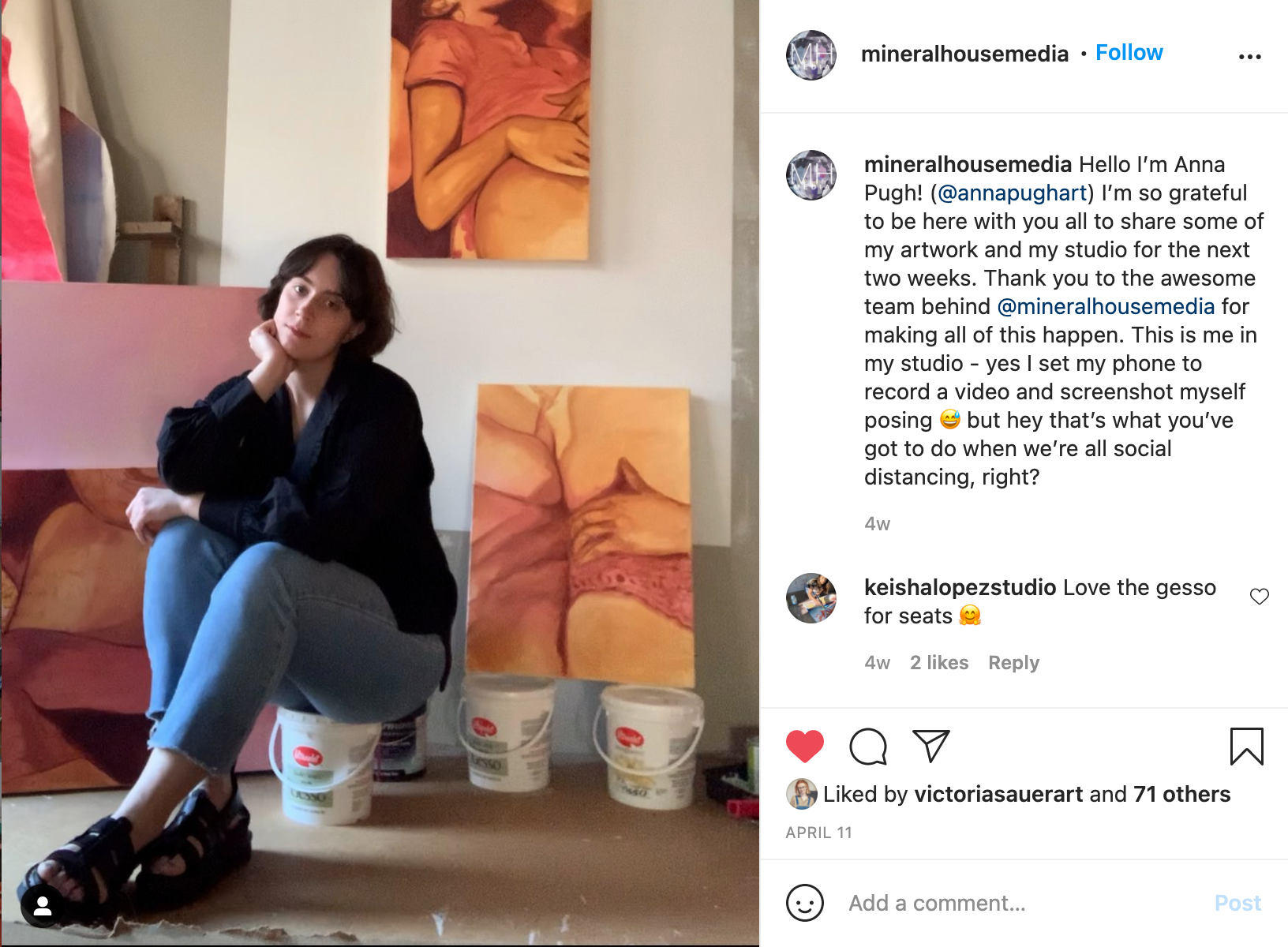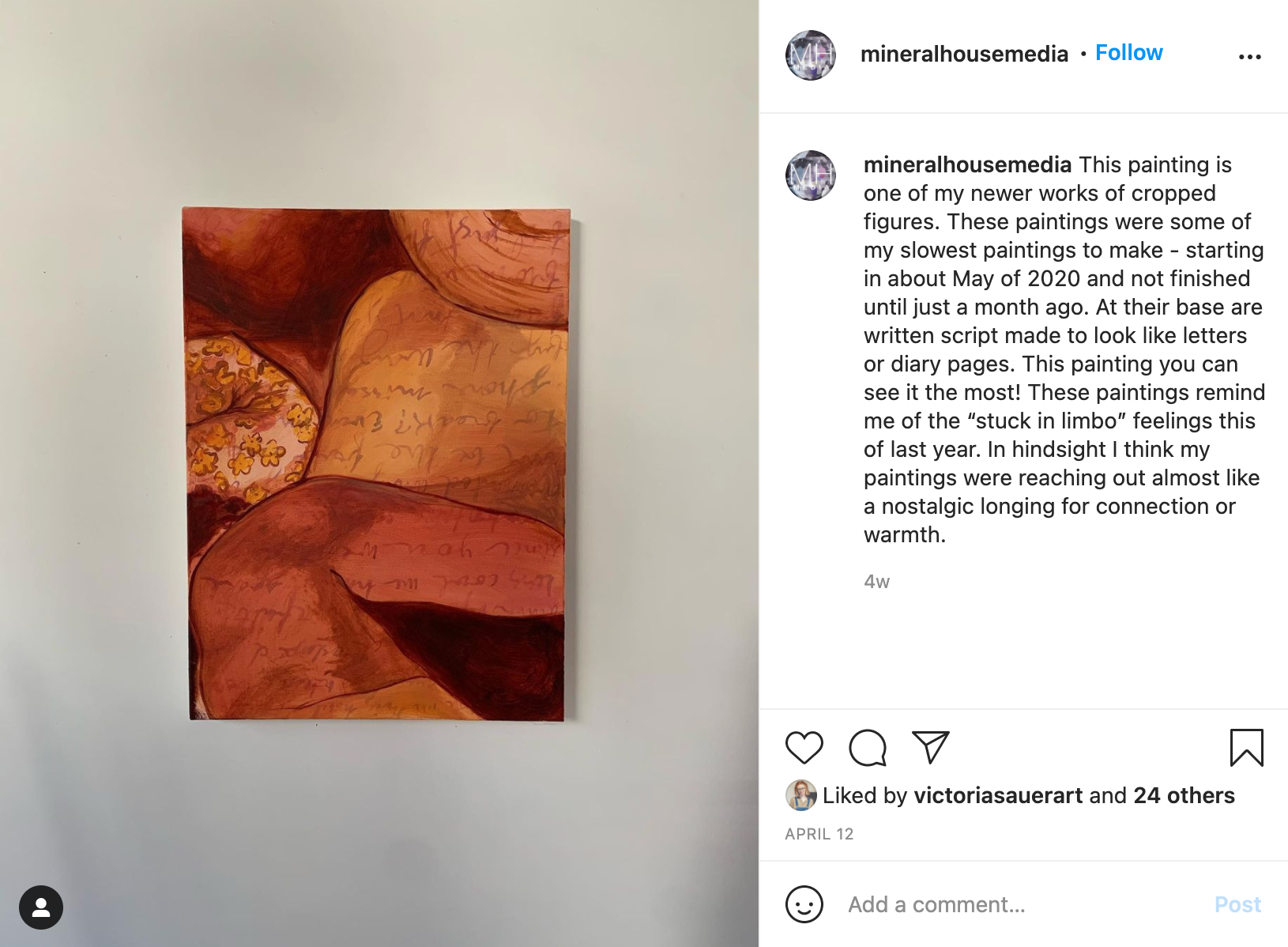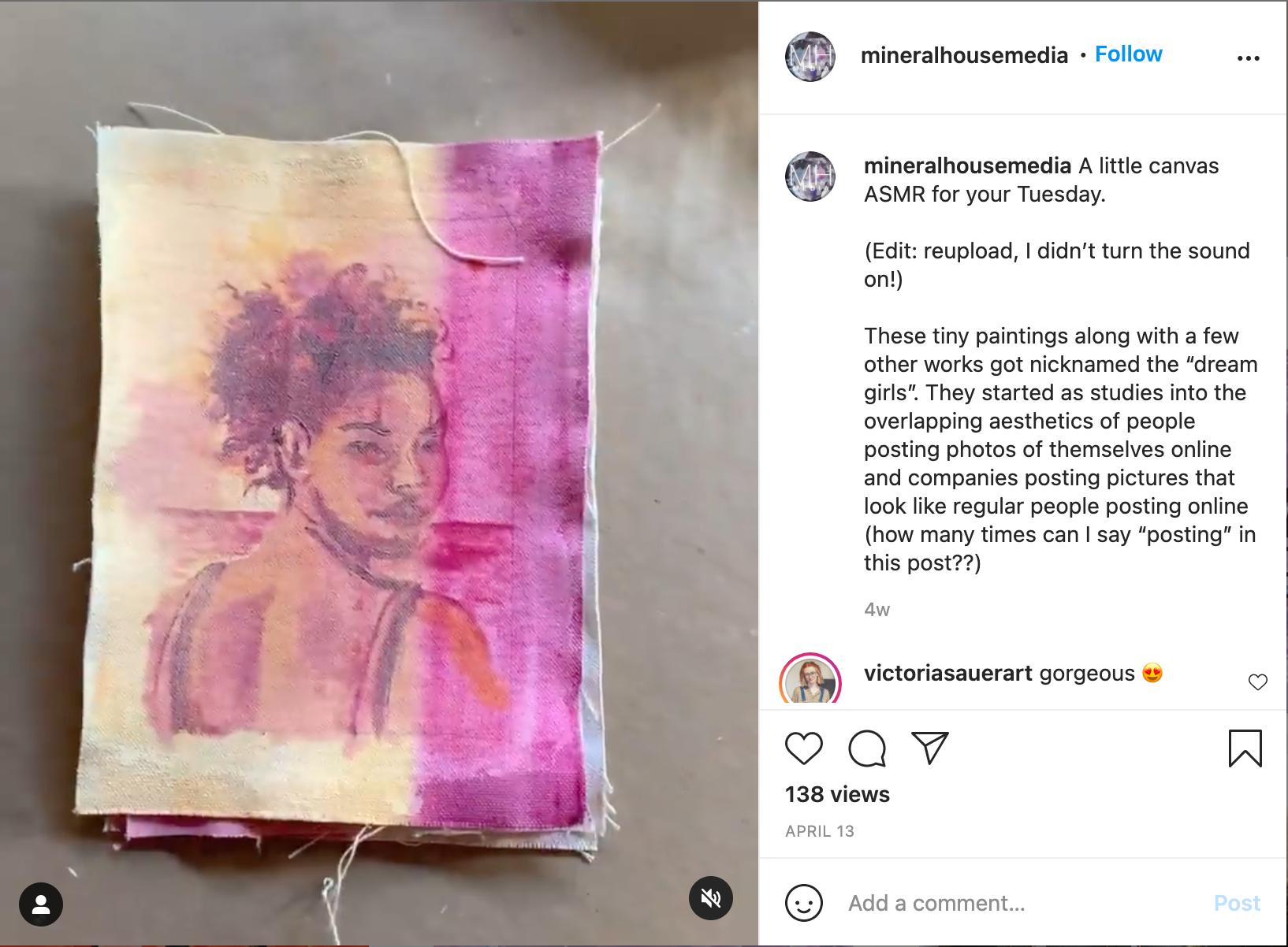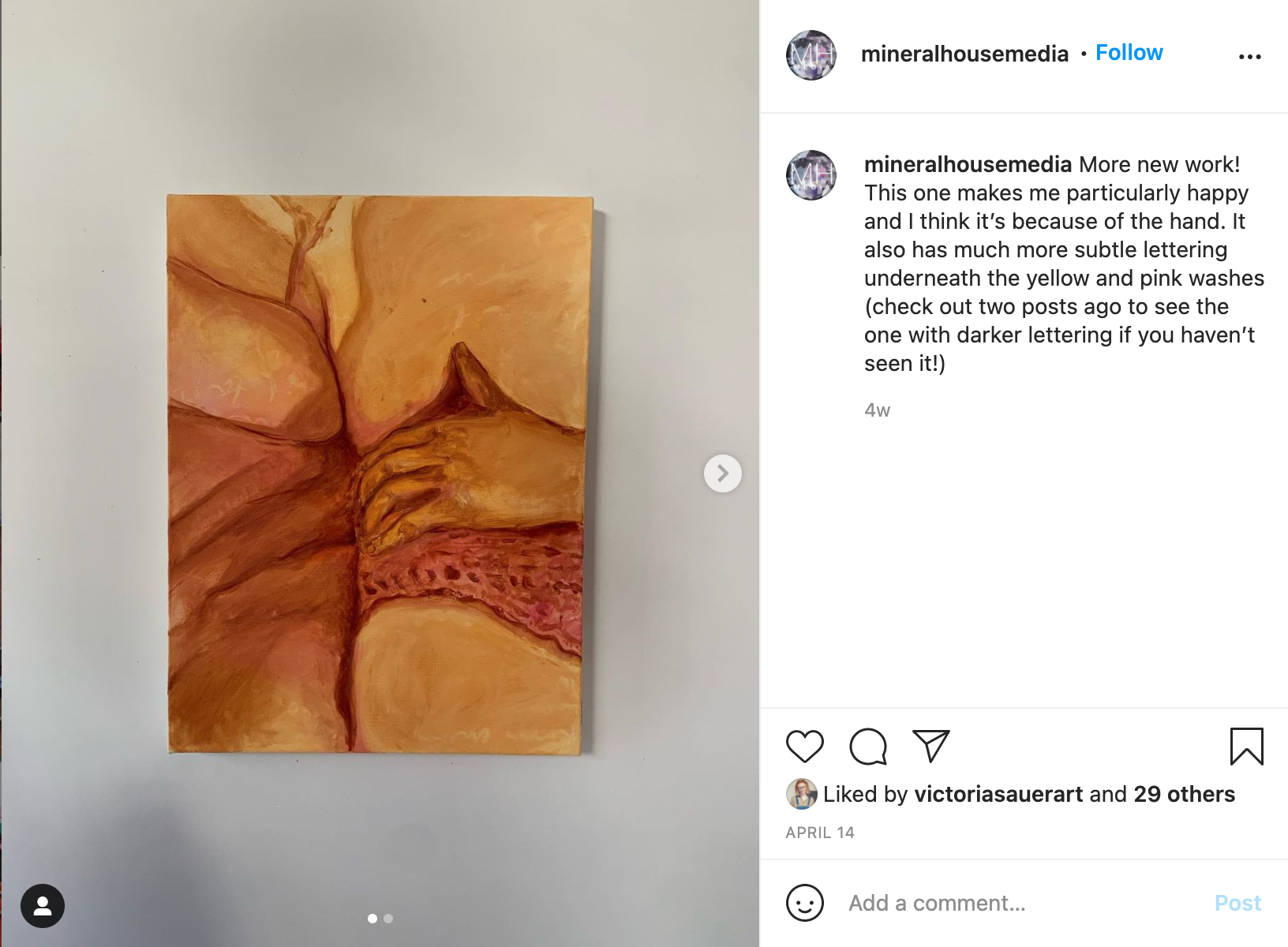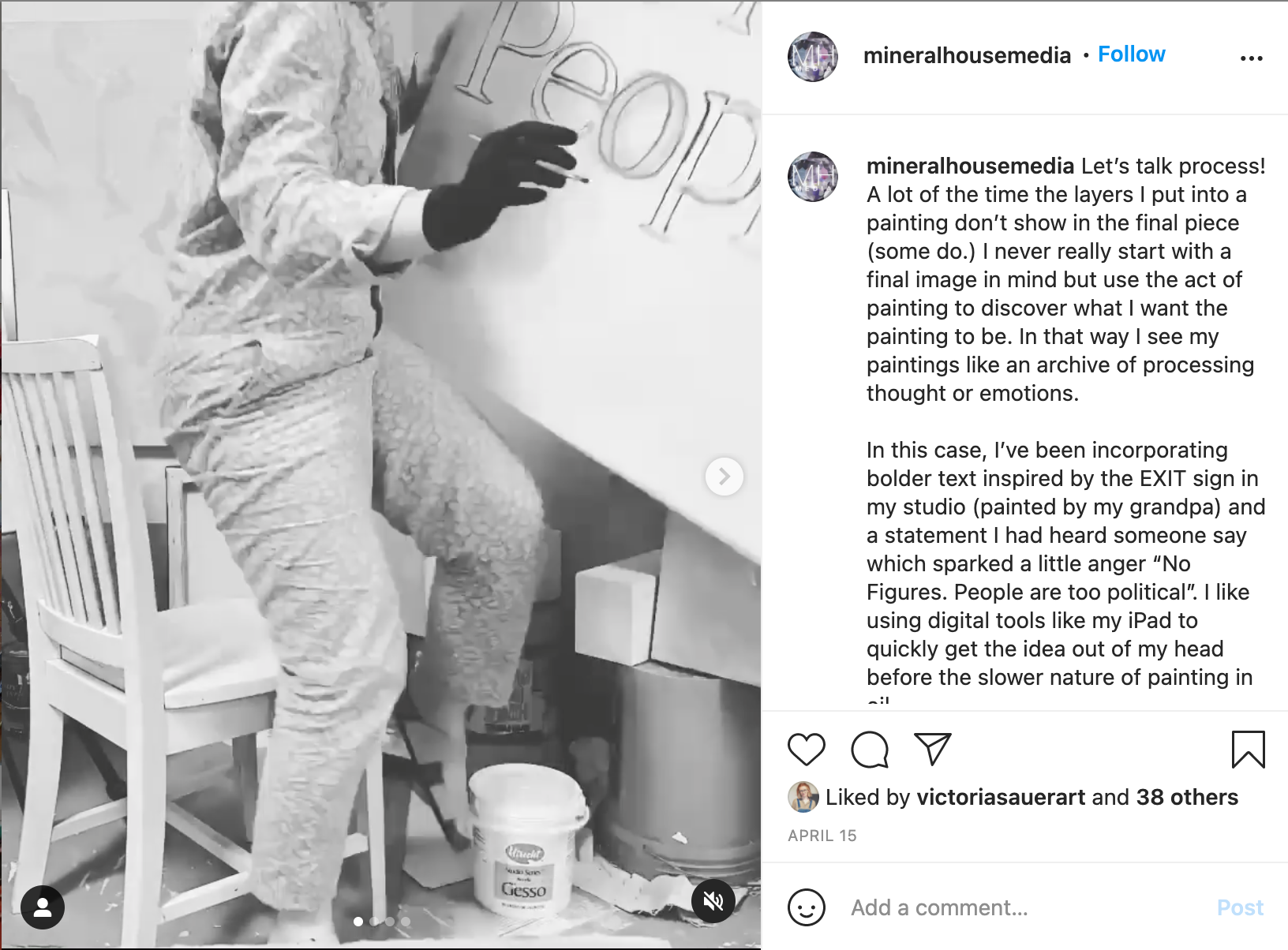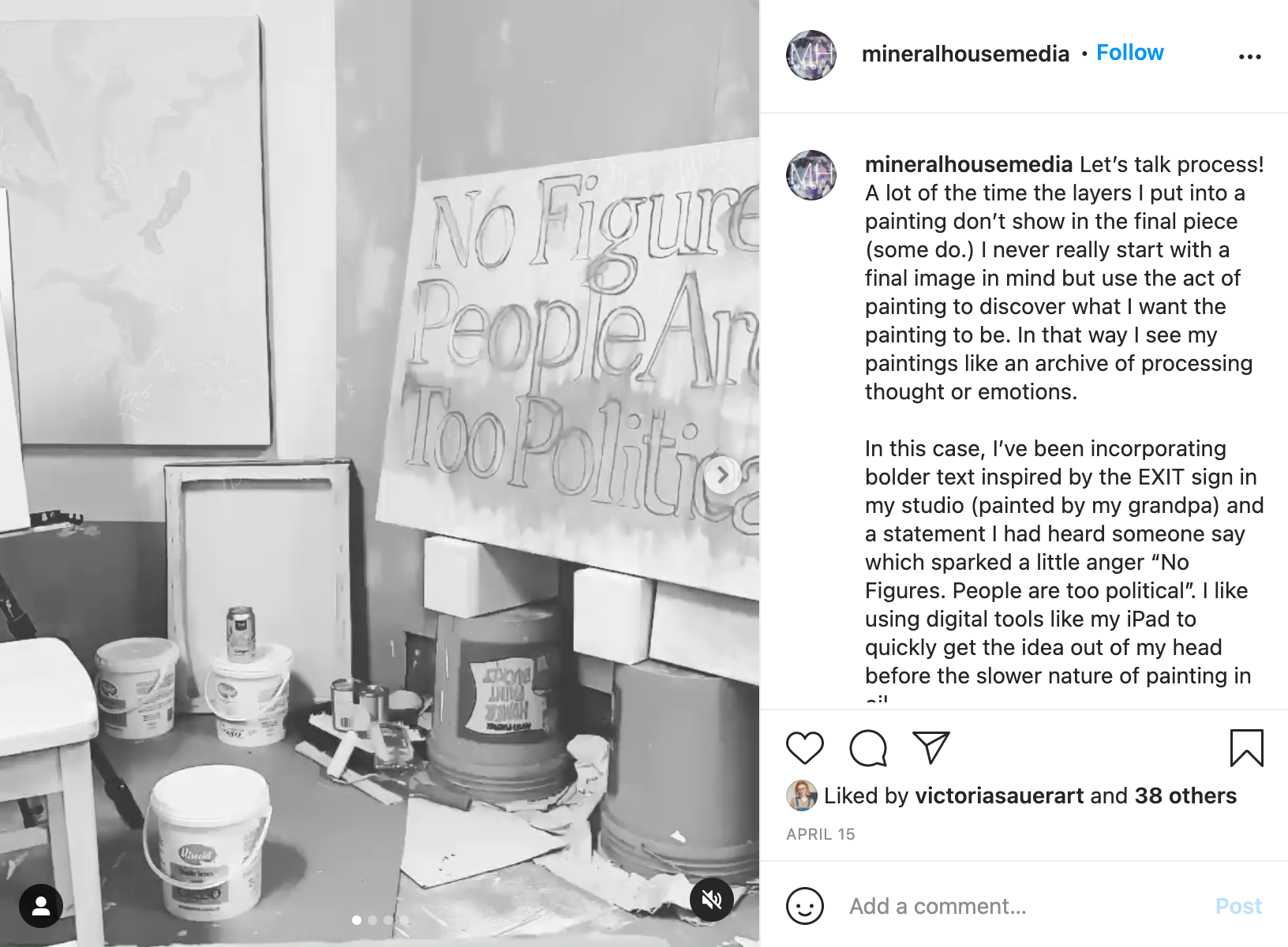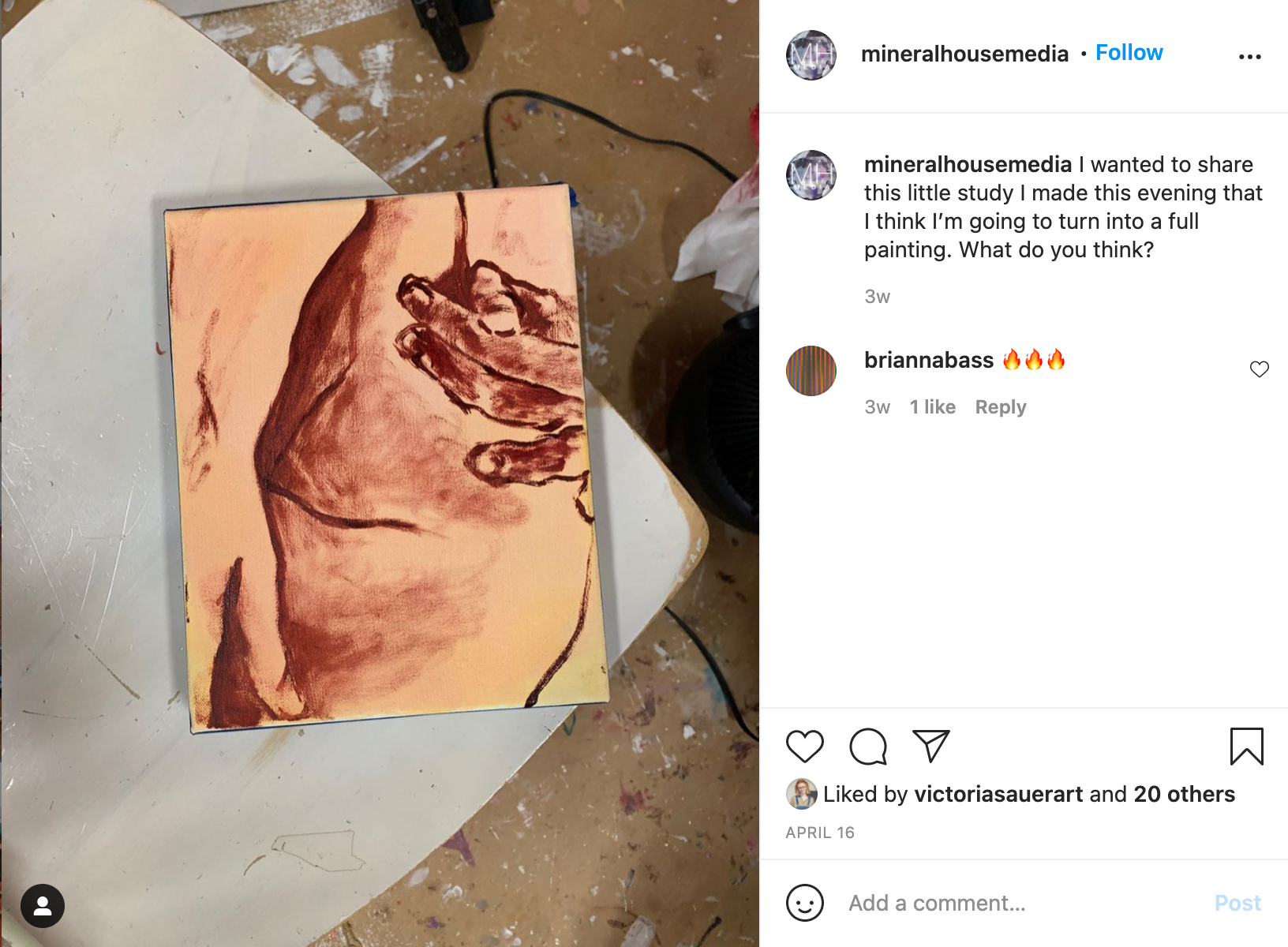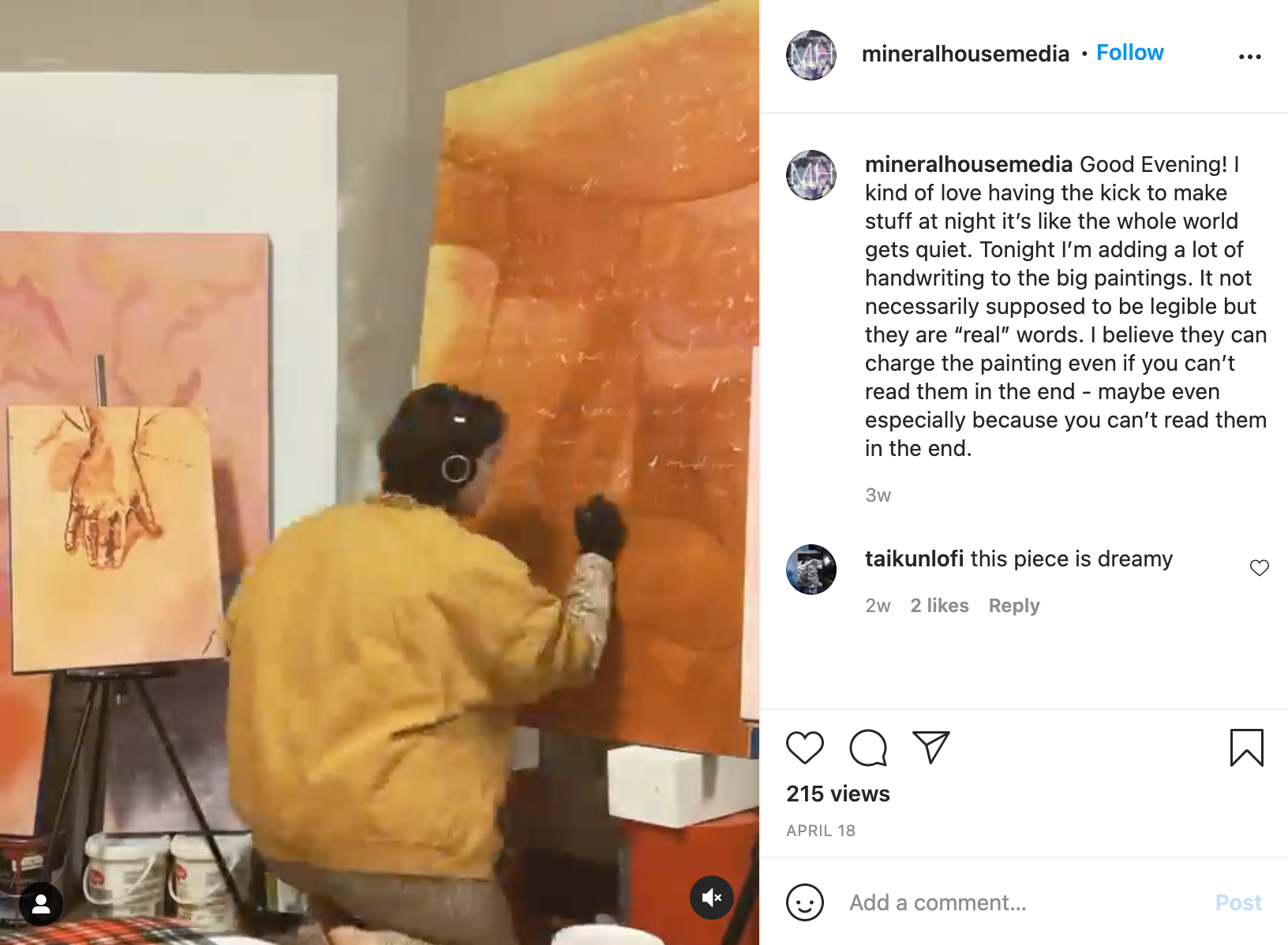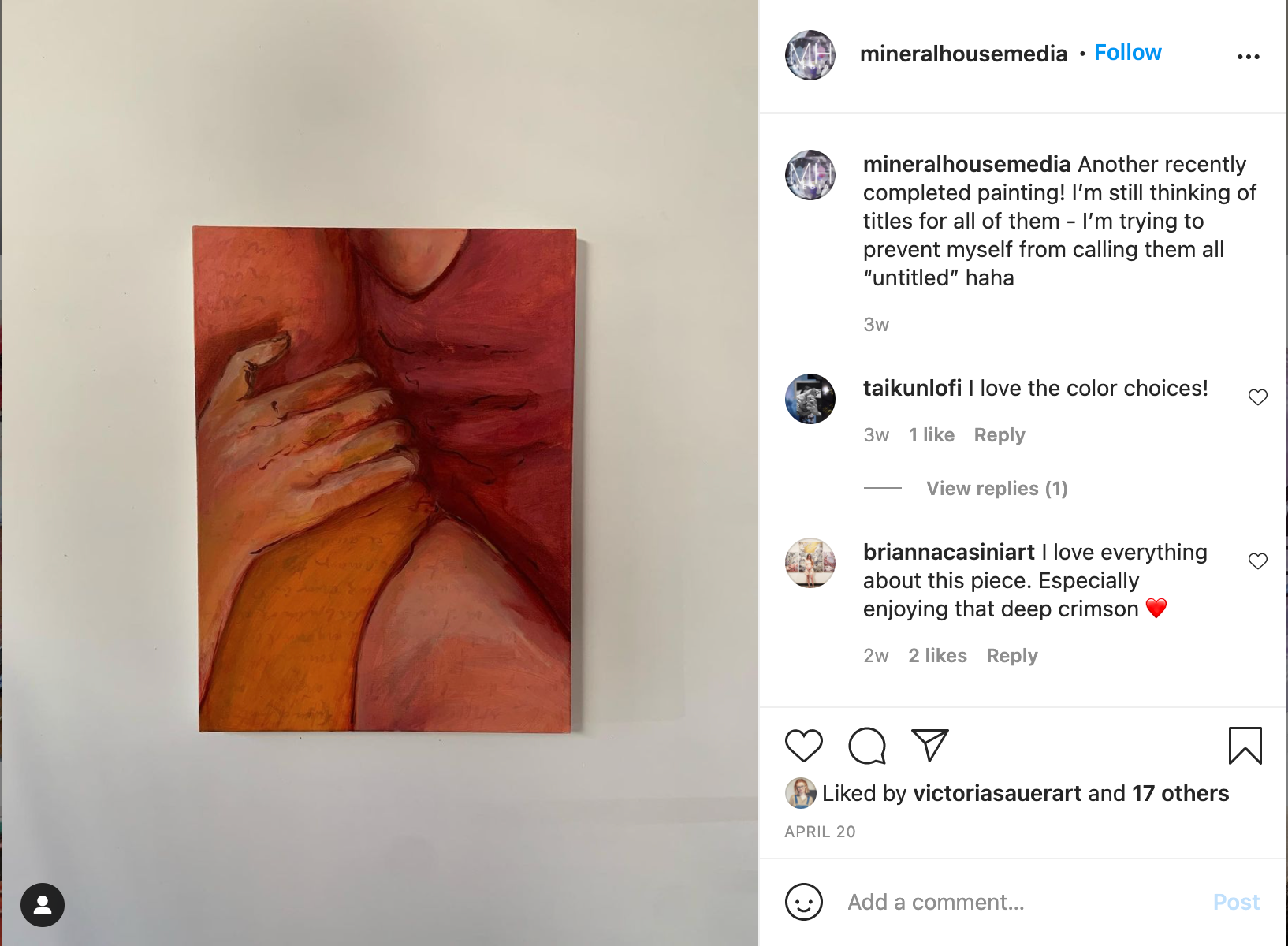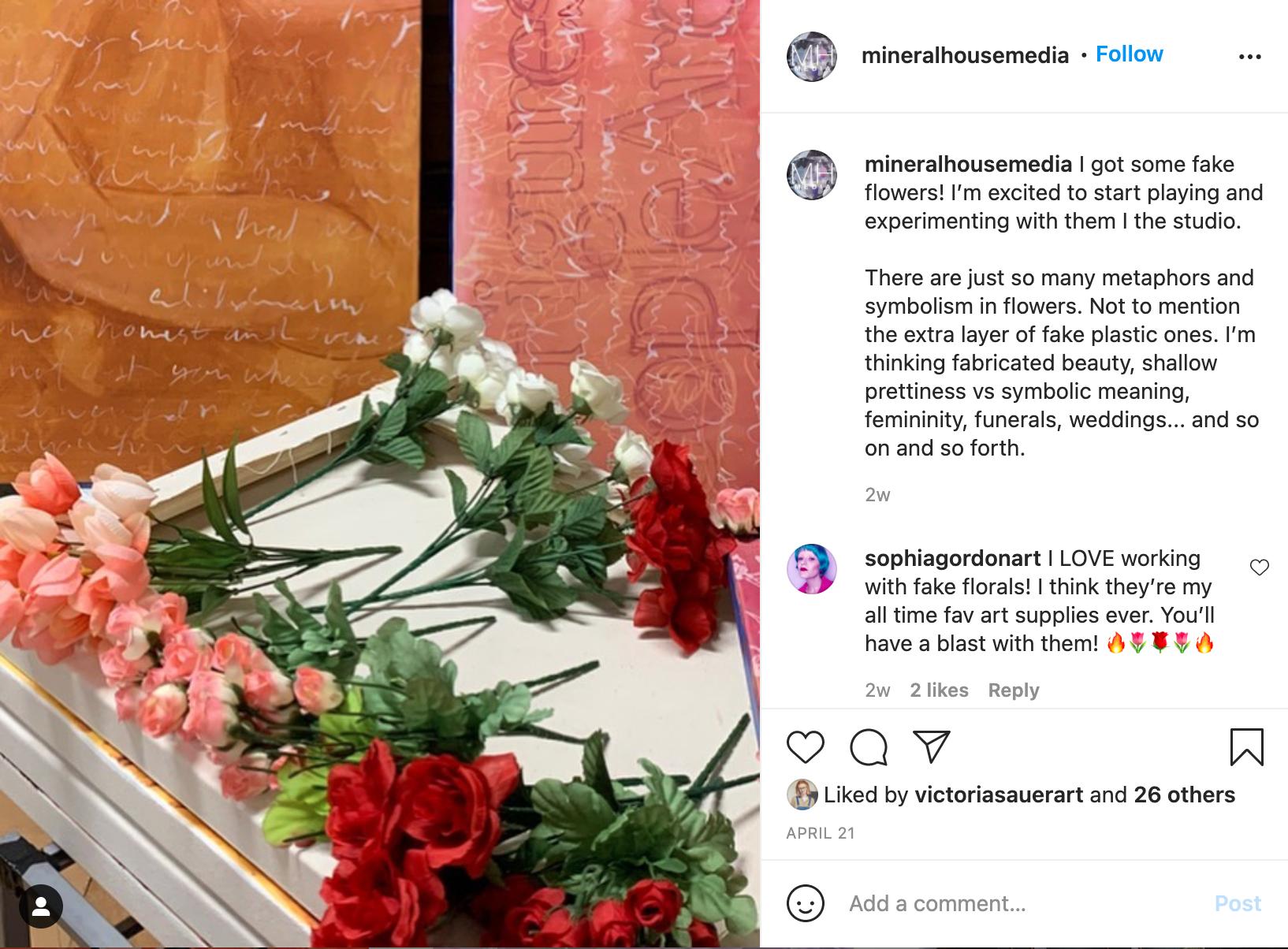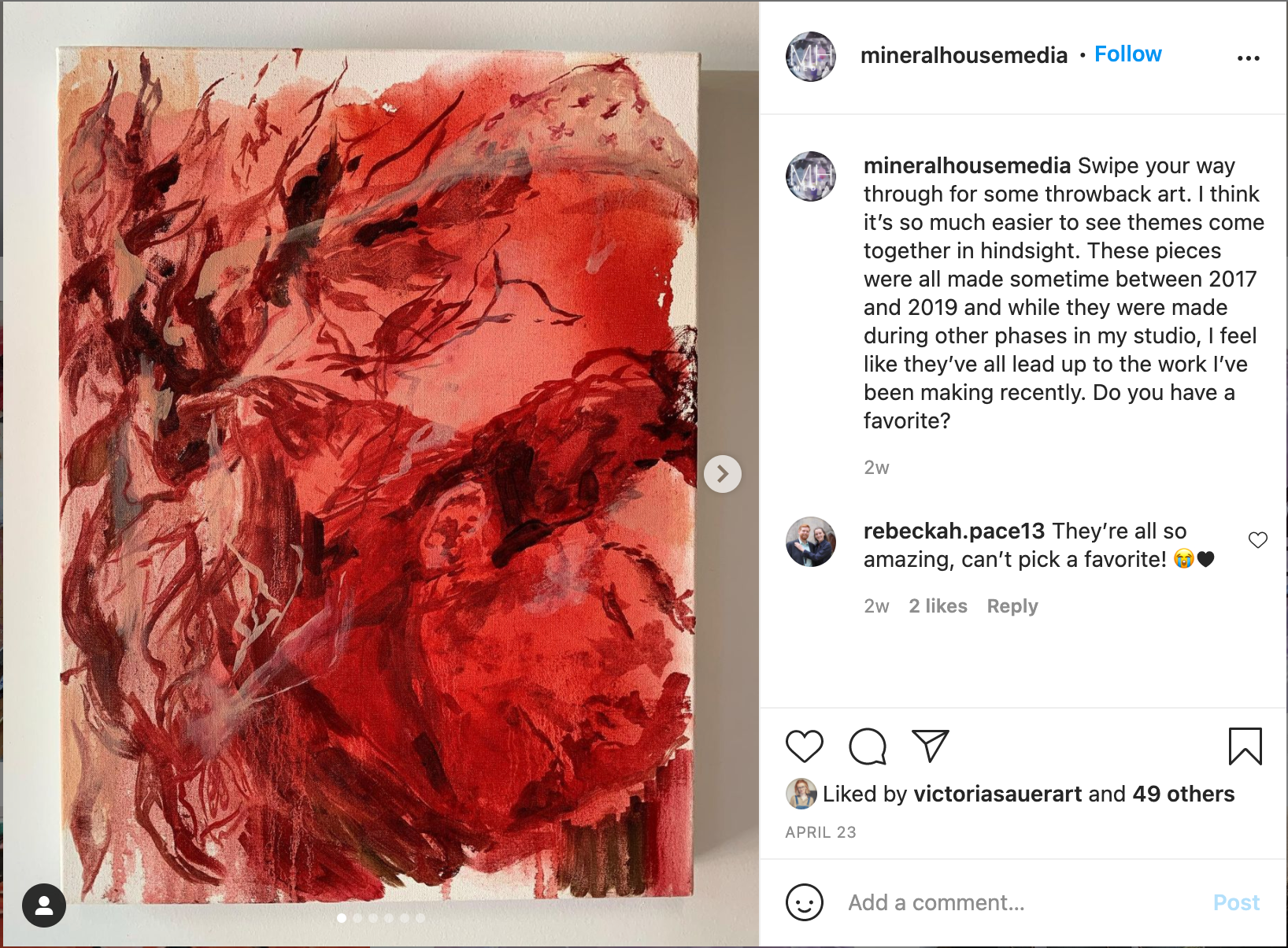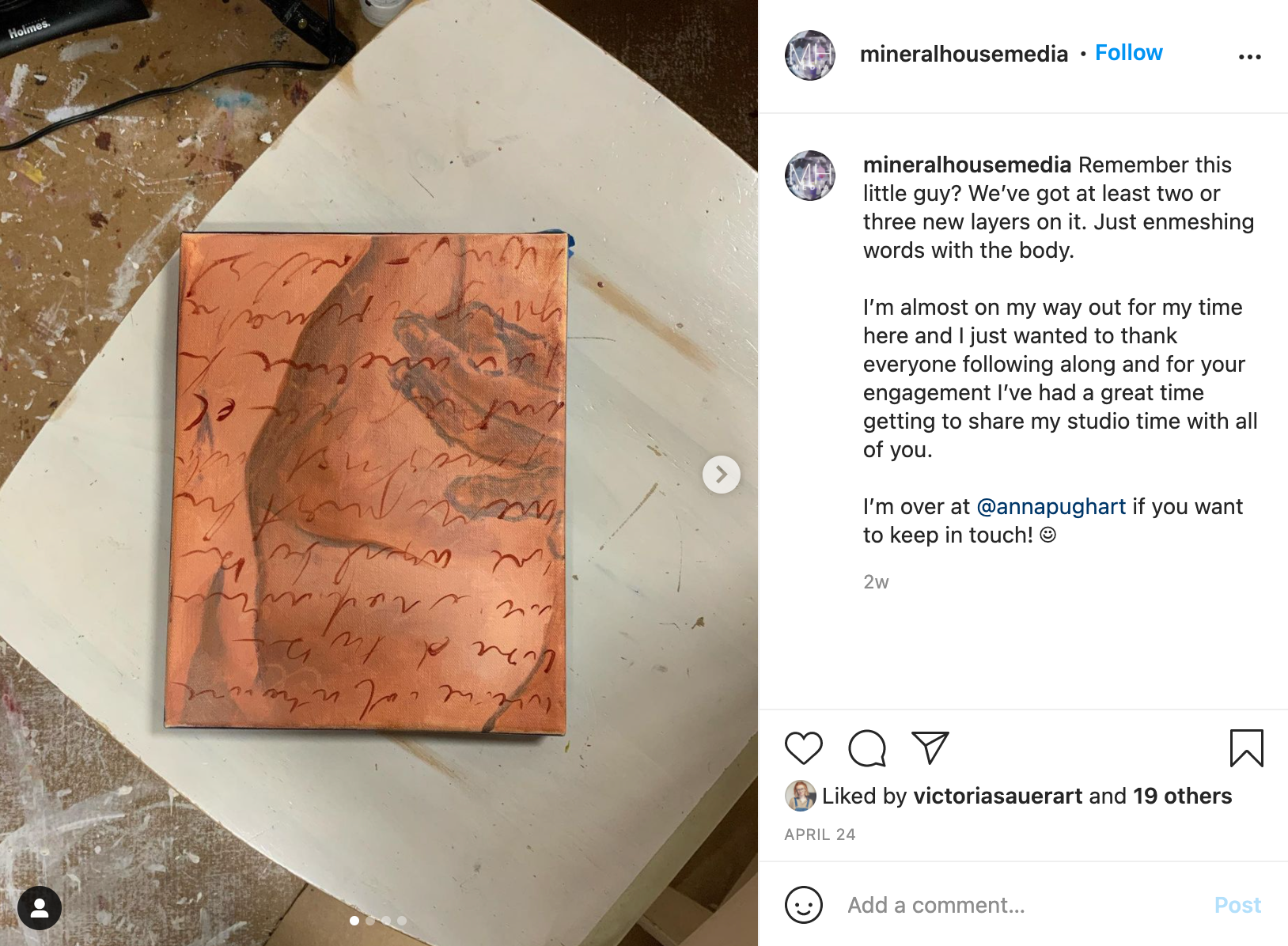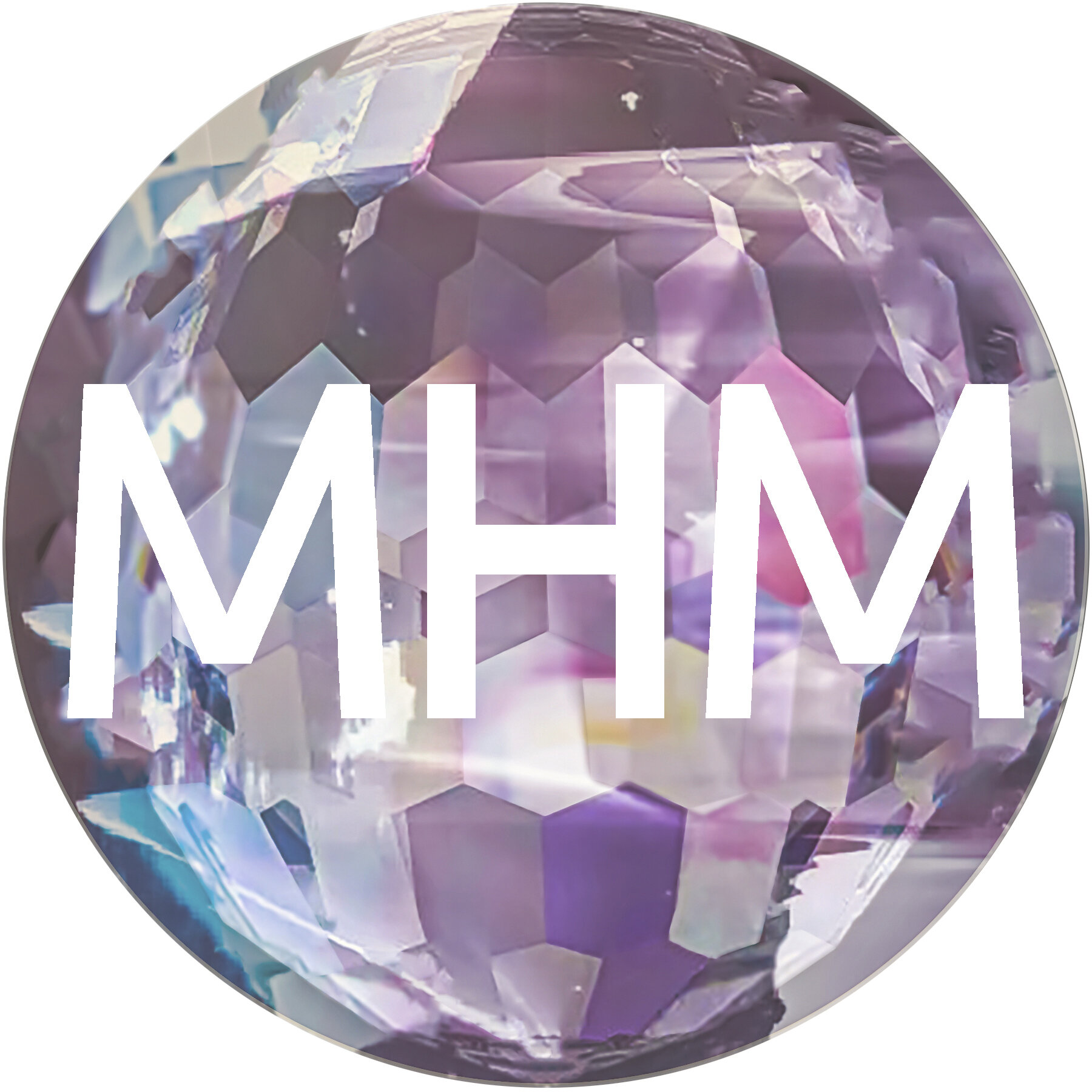Interview with Anna Pugh
Interview with
Anna Pugh
April 2021 Digital Resident
“In my artistic practice, I work with visuals that involve the human body as it relates to perception, intimacy, storytelling, and to a certain extent personal identity and experiences. How these bodies and stories depict and relate to imagination, dreams, and memory are often the starting point of my work. Each project, though, tends to take on more specific routes that pertain to the time and context in which I make them.
For the past few years I have been interested in the imagery used by people portraying their lives on social media and the photos gathered in those digital spaces that are so intimate and so fake. I’ve been creating works keeping in mind the intimacy we feel through the photos we share and keep rather than connection in real life. Pre-pandemic I had started a series I called “Dream Girls” which depicted the imagery of young women as seen so often to advertise clothing and lifestyles. As the pandemic hit and the world was sent into a more introspective period, I began painting the longing for connection. I also began to draw more with ink in an “imperfection sketchbook” which grew to be an almost diary-like confrontation of perfection (in a way, a perfection that also relates to our online image). As I watch these works unfold in real time, I’m noticing an evolution back to works I made as a teenager, works that begin to relate back to my own body and my own relationship with these themes of connection, longing, and the bewildering vulnerability and strength of our bodies.”
-Anna Pugh
Mineral House Media: Warm tones are seen throughout your work, even dating all the way back to the 2017 work you shared with us. What about warm colors enthralls you the most?
Anna Pugh: I do love a good warm tone, don’t I? Well, on one hand there’s just this natural inclination to warm colors. Red has been my favorite color as early as I can remember. But I think I really leaned into those colors because there’s something very alive about warm tones like blood or sunlight. I love how most skin when simplified can fit within a brown, pink, and yellow pallet. Maybe I’m just overcompensating so the bodies I paint aren’t perceived as sickly. Most of my work has been in association with memory and dreams, and right now for me that means giving everything a touch of nostalgia or sentiment. If there’s anxiety or negative emotions in the work, I’m tinting it with rose colored glasses. The yellows and oranges make me think of aged film photos and papers.
MHM: Your work ranges vastly in size—what prompts you in choosing your dimensions? Do you have a favorite size to work with?
AP: When I’m feeling uninspired but still have the itch to work with my hands I’ll just build canvases. Since I have this tendency to make canvases without thinking too hard about what’ll be on them, I try the same idea on different sizes to see how it changes the reception of the painting.
But that’s why I do like working with all sorts of sizes of paintings because I love how it can change the interaction both as the painter and with viewers afterwards. Of course online it’s harder to feel the scale of a work, but I think you can still see the little differences in brush strokes. The larger pieces allow for more detail, but sometimes that detail can get in the way, and when I feel that happening I switch to one of the smaller surfaces.
There are also times when the size is reflective of the subject. For instance, when I made the small “Dream Girl” paintings, I wanted the canvases to be the size of a phone screen so they reflected the origins of digital interaction that inspired them.
MHM: Do you think you’ll ever incorporate 3D materials like the synthetic flowers into your work? Or are they intended as a 2D visual reference?
AP: 3D! I’ve also used flowers as visual references in the past, but I’m hoping to fit in some more 3D elements either into the paintings themselves or maybe as sculptural pieces that go along with the paintings. Playing around with 3D materials is something I’ve always done, but it hasn’t stuck as a final piece of artwork yet (resin, silicone, flowers, fabric, etc.). I’m a confident painter, but I’m so much shyer about sculpting! But flowers have a lot of personal meaning to me, and I’m excited to play with them and find new ways to develop the aesthetics they can add to my figures.
“The writing is more about releasing the thoughts than documenting them.”
MHM: Can you tell us about the writing in your paintings? How is it generated? How do you feel it affects the visual field, and what relationship do you want the viewer to have with it?
AP: Yeah! The writing in my work is fairly new, but it developed from a habit I’ve had forever. I have sketchbooks and journals where there are pages just filled with paragraphs of unfiltered free writing. Sometimes it’s lyrics, poems, stories, letters, or just ideas I’ve been contemplating within my art practice. It’s pretty rare I go back to read them. The writing is more about releasing the thoughts than documenting them. I used to struggle in finding a way to translate them into my final work. One day it clicked, and I decided I didn’t always need to translate them to an image, and I could just write on my paintings.
I also love finding old letters or papers with different handwriting on them, and looking for the way someone else’s hands are present in the marks they left. Handwriting is very expressive of the body in that way.
While making work, I’m thinking about the body as a subject but also about the experience within the body with memory, dreams, and thoughts. And by thoughts I mean the sensation of thoughts—like the rumination or overthinking that may come with elevated emotional states like depression, anxiety, being in love, overwhelm, etc. I’m hoping the viewer doesn’t get too hung up on trying to read the words exactly. Maybe if they catch a word or two that can be exciting, but I ultimately want that sense of embedded energy to resonate with the viewer in the way it blends into the layers of the painting. The words and the figures sort of work to conceal each other in a way that’s simultaneously distinct and vague.
MHM: Do you feel that the work in your “imperfection sketchbook” is more for yourself, or is it meant to be shared and looked upon just the same as your hanging works?
AP: It started as something just for myself—I was going through a stress-induced art block in the middle of the covid lock down. I just couldn’t bring myself to paint for this like two or three month period—or when I did paint it just wasn’t clicking, and I was ruining paintings. So the imperfection sketchbook became a way to break myself out of that by drawing in ink everyday in a cheap sketchbook. The goal was to just draw like a kid—no meaning, no pressure, no need to stick to a particular style or theme—just for fun. Eventually, to keep myself accountable to maintaining it, I decided to share them on Instagram.
“It’s the inescapable nature of today’s socialization and communication. Our personal lives have been seamlessly blended with performance.”
MHM: What kind of revelations about perfection and imperfection have emerged as you practice keeping your “imperfection sketchbook?”
AP: Maybe that nothing is fully perfect and nothing is fully imperfect?
More than anything I recognized how much the idea of imperfection was affected once I decided to share the process. The more I posted the more I was trying to achieve a perfect schedule, and I was getting feedback on the drawings based on how many people liked it which affected me even if I didn’t want it to. The irony isn’t lost on me that I had just been doing a series studying the perfectly imperfect projected images of girls online! And there’s some extra irony in discussing this after doing a digital art residency where I did nothing but post my studio process for two weeks on the same platform—haha! It’s the inescapable nature of today’s socialization and communication. Our personal lives have been seamlessly blended with performance.
MHM: Where do you think the line is between real and fake, when it comes to the social media and advertising that inspired “Dream Girls”? Can’t there be some sort of raw truth in posting to social media?
AP: There can be! That’s why social media is so fascinating because it can be so real and it can also be so fake. And that boundary has just been blurred. I mean, I don’t know where the line is and I don’t think anyone does. The “Dream Girls” themselves were a study into how the aesthetics of clothing advertisements and images from personal social media accounts were indistinguishable from each other. And the imperfection sketchbook shifted after it was put under the view of my followers. In the way I practice art, I use my work as a way of experimenting and discovering as I go. I don’t plan for a final destination when I start working. As I was studying the dynamics in “Dream Girls,” all I could think was wow there really isn’t a difference, is there? What does that imply about other kinds of information? I think it's a new humanitarian dilemma.
MHM: As someone who studies both intimacy and storytelling through the figure, how do you think figurative paintings allow for common experience, despite the specificity of the body being depicted?
AP: Oh I love this question because figures can be so specific, can’t they? At a certain point of specificity they evolve into a portrait. It used to really bother me when people would see my work and the first question they’d ask was “so who is this?” Because to me they were missing the point. So it’s been important to me to find a balance in visuals where it’s less about identity on a surface level and more about identity within those themes of intimacy and storytelling. Psychologically our brains react to other human bodies, and it’s the intimacy and the storytelling that people can relate to on a more common level. So I work to depict something a viewer can project onto instead of feeling it’s completely separate from them.
And you know, now that I’m talking about it, I think this is why I tend to create compositions which are very close to the body. The closeness emphasizes intimacy, but it also begins to take us away from the identity of the figure, and allows us to take a look at the shape of the limbs, the light, the color, the texture, and the feeling the painting gives the viewer.
MHM: What inspired you to minor in biology? How would you examine your work through a biologist’s lens? I'm wondering about perfection, for example, or the sense of closeness your paintings achieve.
AP: Biology was a subject that I just couldn’t get enough of, even if I didn’t think I was going to be a biologist by trade. There’s something addicting about figuring out how the world works, or how people work. How everything is put together and how everything interacts. What it means to be a little human in the midst of it. Honestly, that’s sort of how I feel it is to be an artist as well.
To me, science and art-making are extremely similar. They’re both experimentive, they both can involve long hours in a lab with chemicals or out in the field collecting information, they both involve documentation, methods, and creativity. They both aim to discover and explain the world we live in or the experiences we have.*
When I’m painting I see my canvases as archives to a discovery process or an experiment. Each layer of paint is a layer of thought, or memory, or evidence. And especially with my recent paintings where I’m placing layers and layers of color, figures, and handwriting. Like I said earlier, I don’t go into a painting with a destination in mind but rather some parameters, inspiration, and questions. A hypothesis, if you will. So in that way, I may just be a very poetic and sentimental scientist. Maybe that’s where the feeling of closeness comes from.
*Science obviously has much stricter parameters with methodology and evidence-based conclusions used in medicine and technology. Art explores what is not as concrete and material.
MHM: How do you stay motivated to work in the studio?
AP: The more I treat my studio like a space for myself to explore and play and vent and think, the more I want to spend time there. When I give myself safety in the studio, the work that comes out is more authentic. I try to take all the pressure off, let myself be vulnerable and that’s when all the work I’m proud of comes out.
It’s also nice to remember that “the studio” can be taken with you. If you have some paper and a pencil with you on your lunch break, you’ve got yourself a mobile studio practice.
MHM: Who are some of your favorite figurative painters?
AP: That’s like asking for my favorite songs! Okay okay, off the top of my head and in no particular order here’s the figurative artist playlist:
We’ve got Robin F. Williams, Jennifer Gribbon, Jennifer Packer, Doron Longberg, Sarah Slappey, Anthony Cudahy, Chloe Wise, Emilia Wild Olsen, Nettle Grellier, Devan Shimoyama, Inka Essenhigh, Joan Semmel, Kerry James Marshall. Also I know this shouldn’t even count, but I’m going to add Eva Hesse—her work is so bodily so I say it counts even if it’s not painting nor directly figurative. It’s everything to me. Julie Mehretu also doesn’t fit the category, but she’s going on the list because her layering and gestural line is my bread and butter.
Jenny Saville was also a really formative artist for me. When I was a teenager I got to see a full solo show of her work, and it was the first time I saw the figure being used in contemporary art by a woman so brutally and so expressively. It was my first time feeling like I could identify with and relate to a contemporary artist.
MHM: Do you have any shows or projects coming up that we can keep an eye out for?
AP: Right now I’m focusing on building up new work and collaborating on some projects with friends. Everything is still in a bit of a post-2020 recovery mode, so I’m hoping there’ll be more on it’s way soon.
Anna Pugh is an artist based in Nashville, TN. Anna received her B.A. in Studio Art with honors from Wake Forest University. She received honors with concentrations in Drawing, Sculpture and Painting, and even tacked on a minor in Art History and a minor in Biology for good measure. Her paintings have been displayed at multiple group shows and solo shows at locations including START Gallery (NC) and Open Gallery (TN). Currently, Anna works as a practicing artist, gallery associate and as a freelance illustrator and designer. Her illustration and design work ranges from album cover art, to artist portfolio websites, to merch designs for musicians.
